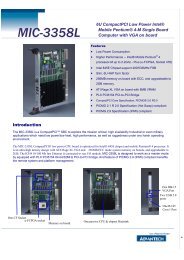industrial wireless book special edition - Networking ...
industrial wireless book special edition - Networking ...
industrial wireless book special edition - Networking ...
You also want an ePaper? Increase the reach of your titles
YUMPU automatically turns print PDFs into web optimized ePapers that Google loves.
Two case studies<br />
Wireless solves problems that were too difficult or too costly to approach previously using hard-wired<br />
solutions. For example, a Middle-Eastern customer’s remote pumps needed performance monitoring<br />
so that engineers could make informed maintenance decisions.<br />
Previously, this customer had used a portable vibration analyser. The maintenance people would go<br />
to the pumps, collect data and make a decision. However, these pumps are sited in the middle of the<br />
desert with an eight-hour drive for access. Often, trips would be made and a pump would not be running,<br />
so data couldn’t be collected. It was too expensive to install an online vibration monitoring system, so<br />
each pump ran until failure.<br />
To resolve this problem, accelerometers fitted to the pump casing with the transmitter located close<br />
by communicate <strong>wireless</strong>ly to the w-HART gateway, which connects to the main control system over<br />
a WAN. This vibration data is communicated through the customer’s automation system to the enterprise<br />
historian, which makes the information available to the reliability engineer at his/her desk through the<br />
corporate Intranet.<br />
If customer’s reliability engineer – 350km away – sees a pump problem on the historian, he or she,<br />
could phone the operations team, who could go out and correct the problem. Such difficult to traverse<br />
distances lend themselves well to <strong>wireless</strong> applications.<br />
In another application at a Middle East wellhead, a customer has about 2500 <strong>wireless</strong> devices across<br />
many gateways collecting well data, something that was difficult and slow to deliver with a hard-wired<br />
system. Temperature devices show the customer whether product from each well is flowing. Previously,<br />
they had teams driving around the field in trucks and putting their hands on pipes to determine if the<br />
well was producing. This customer found that the payback period was nearly instantaneous, given the<br />
tremendous savings in maintenance and operating costs. Water wells are a similar application in the<br />
Middle East, and in many parts of Africa.<br />
TCP/IP connection; AMS HART TCP/IP; HART<br />
port; and Modbus serial connection.<br />
The <strong>wireless</strong> field network comprises several<br />
w-HART devices communicating in a selforganising<br />
mesh network to a w-HART gateway.<br />
For host systems not supporting w-HART native<br />
integration, Modbus Serial, Modbus TCP/IP and<br />
OPC DA can all be used to directly connect to<br />
the w-HART gateway. Figure 2 shows a <strong>wireless</strong><br />
integration of the w-HART field network via a<br />
Modbus TCP/IP interface.<br />
Working with <strong>wireless</strong><br />
In brief, the advantages of <strong>wireless</strong> over<br />
hardwiring are:<br />
● Less expensive;<br />
● Faster to install;<br />
● Easier to maintain;<br />
● Less susceptible to wear and damage;<br />
● Works in almost any terrain;<br />
● Better for mobile assets (Fig. 5).<br />
Instrument engineers know how difficult it<br />
can be to hard-wire a field instrument such<br />
as a flowmeter or a level transmitter, back to<br />
an automation or information system. One<br />
reason that w-HART has been adopted quickly<br />
by the process industries is because it’s so easy<br />
to use.<br />
With conventional hard wiring, precautions<br />
have first to be taken to ensure that it will be<br />
safe and will meet all hazardous-area requirements.<br />
Next, hard-wired cables have to be<br />
routed through cable trays and I/O concentrators,<br />
and through marshalling cabinets or<br />
junction boxes at great expense in labour and<br />
equipment. Such wiring can be difficult to<br />
maintain. Wireless obviates such difficulties,<br />
and specific advantages include savings in<br />
wiring and related components, fewer cabinets<br />
and conduit systems, less need for ancillary<br />
equipment such as space heaters and cabinet<br />
cooling systems, savings in time and money, as<br />
well as a smaller footprint and less weight.<br />
Being a mesh network, w-HART <strong>wireless</strong><br />
devices talk to each other at a range up to<br />
Fig. 3: WirelessHART system architecture diagram.<br />
Modern <strong>wireless</strong> mesh networks like WirelessHART<br />
allows users to link <strong>wireless</strong> sensors and instruments<br />
from multiple vendors to an automation system and/or<br />
information system.<br />
100m, and autonomously form <strong>wireless</strong><br />
communications paths back to a local gateway<br />
(Fig. 3). This makes for very easy and fast<br />
installation and commissioning.<br />
To commission an installation of <strong>wireless</strong><br />
sensors, a user starts with devices closest to<br />
the gateway. As these power up, they become<br />
aware of their neighbours and make automatic<br />
connections. As more devices are added, they<br />
self-organise into mesh networks. A user<br />
doesn’t have to tell the devices which other<br />
devices or gateways they should look for as<br />
these tasks are handled by the gateway, which<br />
may contain a network manager. Once the mesh<br />
has formed, any changes – such as by a<br />
permanent or temporary obstacle – will be<br />
managed by the devices themselves finding an<br />
alternative path to the gateway.<br />
Overall, a <strong>wireless</strong> system is much simpler<br />
to modify than its wired counterpart. If a<br />
device changes or moves, it’s not necessary<br />
to make wiring changes. If more devices are<br />
needed, another gateway can be added which<br />
will handle 100 more devices.<br />
The redundant data paths inherent to a mesh<br />
network eliminate single points of failure. Real<br />
installations consistently demonstrate greater<br />
than 99% data reliability. w-HART uses a full<br />
mesh-topology as many as seven hops deep,<br />
so a costly infrastructure of multiple backbone<br />
routers installed throughout the plant within<br />
range of every <strong>wireless</strong> device is not needed.<br />
Running expensive hazardous area power<br />
supplies to backbone routers is also not required.<br />
Available tools help plan and monitor the<br />
networks, analogous to Foundation Fieldbus<br />
and other hard-wired sensor and instrument<br />
systems. As with these hard-wired networks,<br />
the required tasks are similar – follow best<br />
practices, plan the network and it should work<br />
without problems.<br />
Built-in security<br />
With no physical barrier surrounding <strong>wireless</strong><br />
plant networks, <strong>wireless</strong> security is crucial to<br />
the successful deployment of field instrument<br />
networks and plant application solutions.<br />
Attack vectors include rogue APs, ad-hoc<br />
<strong>wireless</strong> bridges, man in the middle (Evil Twin,<br />
Honeypot AP, etc), denial of service (DoS),<br />
jamming (also considered DoS), plus reconnaissance<br />
and cracking.<br />
However, w-HART communications use a<br />
security protocol with 128-bit encryption and<br />
24 hex join codes, making hacking difficult.<br />
Another important security feature is that there<br />
is no IP address in the <strong>wireless</strong> devices, making<br />
it very hard for would-be hackers to make initial<br />
penetration. Other security measures include<br />
encryption, authentication, verification, key<br />
rotation and sequence number. Moreover, this<br />
security cannot be turned off, ensuring these<br />
measures are constantly active.<br />
There are three main parts to a <strong>wireless</strong><br />
defence-in-depth model:<br />
<strong>industrial</strong> <strong>wireless</strong><br />
sponsored by Advantech<br />
<strong>industrial</strong> ethernet <strong>book</strong><br />
49

















